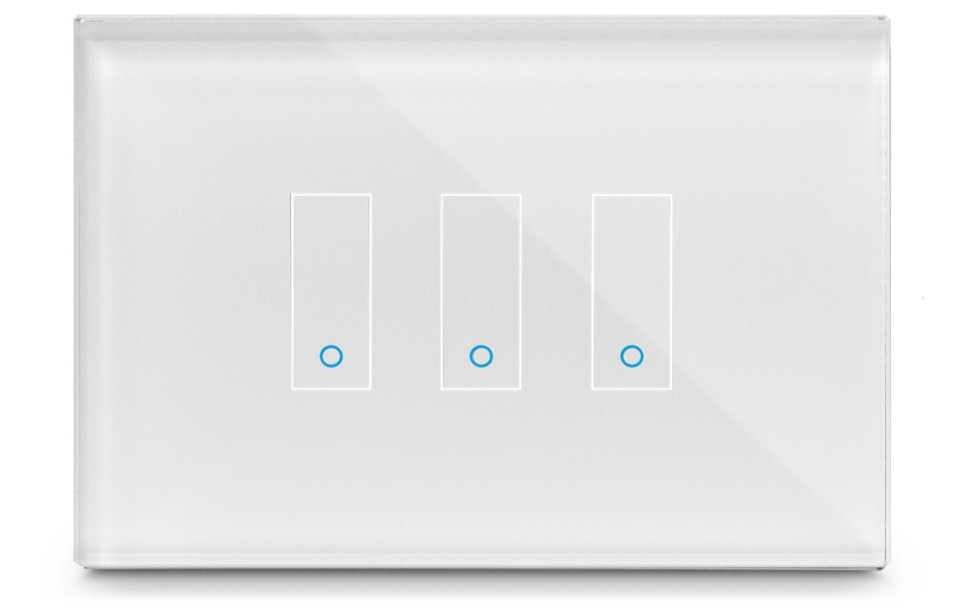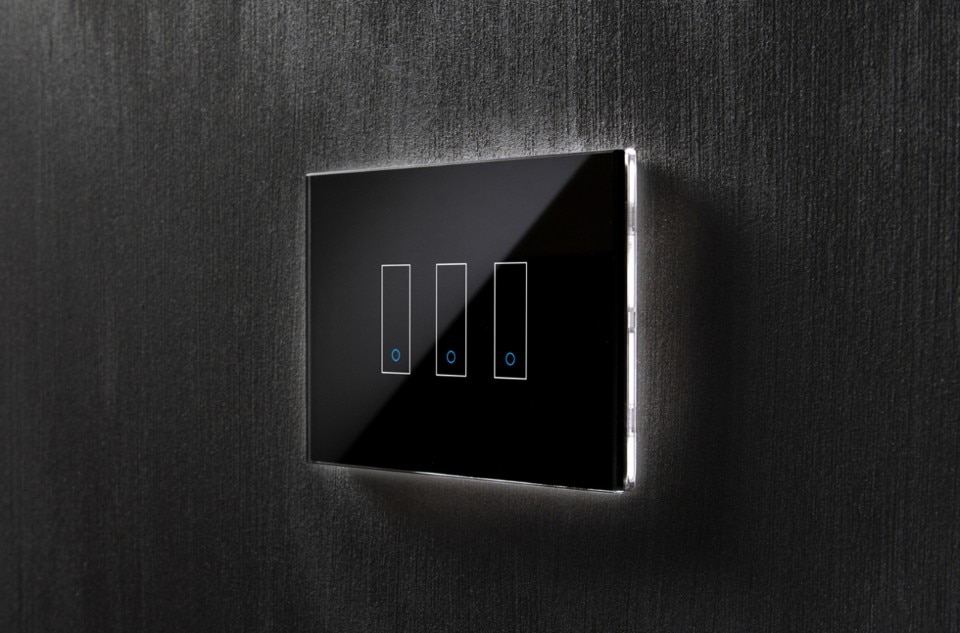The first product of the Italian start-up iotty (all lowercase) is a very well-done Wi-Fi Switch. Elegant and retro-futuristic, with fluorescent lights and Automan vibes, iotty Smart Switch is really a one of a kind on the market: without ever being tacky like many other technological products, it has replaced the old traditional switches in an innovative, intelligent, and minimalist way.
Today the catalogues of Amazon and specialized retailers offer an endless variety of smart plugs, which allow to hook lights and appliances to Alexa or Google Assistant and pave the way for the spread of smart homes, at the cost of filling all your power strips and sockets with bulky boxes connected to your home Wi-fi connection. iotty, on the other hand, represents the elegant and minimal solution that replaces all home switches with a digital version with intelligent functions. "There were no such products in Italy," explains Edoardo Cesari, co-founder of iotty. For the most part, you can find on Amazon and other online stores many low-cost, non-certified Chinese switches produced for the United States, which are then modified to be used in Italy, he explains. iotty was first launched in the USA - undoubtedly the most advanced market in the world in terms of smart homes. Thanks to this product so special, cared-for and different, the small start-up quickly conquered the market. "It's undeniable, its design made all the difference, especially in America". But also, its quality and certifications. Now iotty is bringing the "wow effect" of its switches to Europe, going back home: because it all started in Italy.

What is iotty’s story?
iotty was born from two Italian companies that have about a hundred employees. The first one is a software company that works with very important firms in northern Italy and has always been interested in new technologies. When four or five years ago 3D printers began to spread, this company began to experiment and train itself in the so-called maker world. Then, microscopic WiFi, Bluetooth everywhere, and low power consumption arrived: we understood that it was possible to put Internet inside things. We started to create all kinds of prototypes, lights for example. Objects with Wi-Fi.
When did you turn your prototype into the final product?
About two years ago, the second company joined us. They have been printing circuit boards for 20 years, they have hardware and scale-up skills, and they are used to producing in China. And they also have an already beautiful and attractive touch platform, so we could put the Internet of things "inside" of it. We decided to focus on the switches because there would have been too many competitors on the thermostats. We set up a crowdfunding campaign in America because here crowdfunding works very well, and we knew that we needed time, at least a year, to start with the product. At that point, we launched it in the United States, where we were already present in big retail chains (like Best Buy). Meanwhile, we were working on a device that could work in 90% of the markets. And at this point, in March, we launched in Europe, in 3 countries: Italy, Germany, and France.
Where does the name come from?
The name comes from Iot, the Internet of Things, of course, and from the search for an interesting name that hadn’t already been taken, and that therefore had a free domain.
When you have a smart plug, you just need to plug it in and connect it to your home Wifi: it's an almost obvious gesture, but it embodies most of the smart home philosophy against “old” domotics. What about iotty?
If you want, you can buy iotty with or without installation online, even on Amazon. The challenge of the smart home is to create an object directly for the final consumer, who wants to unbox - as it is fashionable to say - the product and do everything by himself by following the instructions. Obviously, you need also a minimum of knowledge, so we have partnered with a group of installers to provide an extra service to our users in Italy and France. You can also buy the installation later, separately. For example, 5 smart switches plus installation cost 499 euros. Only the installation, in this case, costs 149 euros. To become a iotty certified installer you need to pass an exam. It is a rather structured process. Otherwise, if the users want to install it by themselves, we offer a very efficient customer care service, that can help with the installation through an app.
Why did you choose to be so consumer-oriented?
We started in the USA, and here the market is mostly consumer oriented. We could start working on a smart skyscraper, of course, but it would be harder for us because we don’t have such a big distribution network. Even the gigantic Google somehow found itself facing a similar problem with Nest.
Will you launch more products in the future?
We are planning on completing the line with many do-it-yourself products that include, for example, the recessed sockets that we will present at Ifa Berlin. They will be illuminated inside, with a cockpit emitting light. We are also working on new plugs and also a dimmer, which is very much in demand especially in America. In the future, there will also be shutter switches. iotty could already do that today, but it would not be perfect. And then, to complete the line, we would like to create a thermostat, - in the end, a thermostat is just a plate, right? Then, we're also thinking of other types of objects, such as door openers. Of course, we want every object to have our aesthetic imprint. We aim to create amazing recessed objects, with a very impactful appearance.
Smart homes are succeeding in doing what domotics couldn't
You seem to really care about the aesthetics of all your products.
We're design freaks.
How many of you are working on iotty?
About 25 people are working on the project right now, 50% of whom are abroad. Research and development are done in Italy. 7 or 8 people are working on the design. Then we design the prototypes and study them: how's the light?, and how does it spread? When we feel satisfied with the mechanical part, we start working on the screen printing, we stylize the glass part and finally, we optimize everything through a specific procedure.
Are you satisfied with the result?
We worked a lot on the backlight. Inside the object there are light diffusers, and developing them was not easy. Between the glass and the wall, there is a layer of transparency to increase the diffusion effect, which is also adjustable. We tried to make it as elegant and minimal as possible. Even the designing the switch itself wasn’t easy, we wanted to avoid the home automation effect - if a friend enters your house, he does not know how to switch on the lights. We wanted something that everyone could understand. So, we created a switch that looks just like a switch. Of course, it's more than a switch that works with the touch, rather than with analogue buttons. In my home, where Iotty is everywhere, I often turn on the lights manually. It's very important to leave this possibility open. Then there's the vocal part and the automation, like the porch light that lights up exactly when the sun goes down. Google knows the exact moment.
What can you do with iotty?
It is a very nice switch, touch-sensitive, easy to use. You can adjust the sensitivity of the touch from the app. You touch it and you turn on the lights. You touch it again and you turn them off. If you connect it to your home Wi-fi connection, you can get a lot of automation: for example, if you get close to home or if your smartphone connects to your Wi-fi the lights turn on. You can use Siri or Alexa, create smart functions or new functions: for example, a "free" button can become the button to switch on and off all the lights in the house. Or you can connect a device to a switch, without having to wire it. This differentiates it from smart bulbs, which are smart but do not allow all these interactions.
There is also a built-in burglar alarm function.
It is the function that allows you to randomly turn on the lights to simulate your presence in the house. But you can also do many other things, such as switching on more lights in succession: for example, first in the corridor and then in the bathroom, or on the staircase and then in the attic. And the backlight also acts as a night-time safety light. iotty is a real lighting experience.
So now it's settled: the home of the future will be smart.
Smart homes are succeeding in doing what home automation couldn't. What ten years ago would have cost you 50,000 euros, now only costs 2,000. And the market is reacting well.


